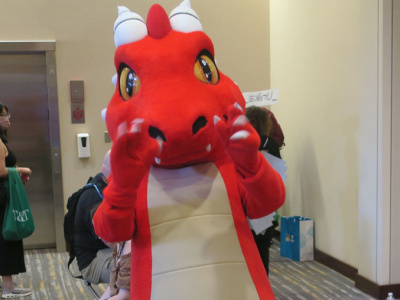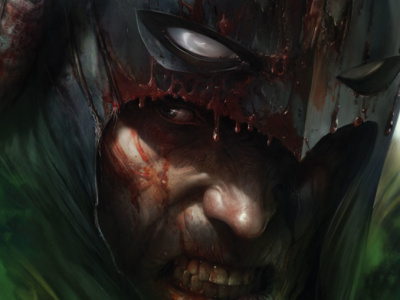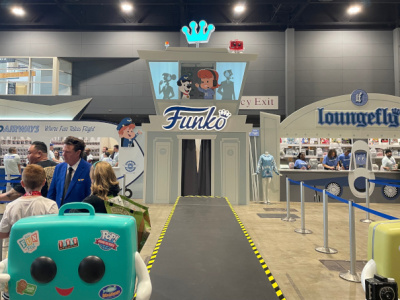 ICv2 spoke to DC Comics Executive Vice President of Sales, Marketing, and Business Development John Rood and Senior Vice President of Sales Bob Wayne about the recently released October sales numbers on the New 52 (see “DC Crushes Marvel” and “New 52 #2s Down Only 6%”). In Part 2 of this two part interview, we talk about DC’s graphic novel strategy for the New 52, the characteristics of the consumers that are buying the New 52, and why there seems to be so little speculation on the relaunch books. In Part 1, we talked about the over-all sales trends, digital sales, and DC’s deal on the Kindle Fire (see “Kindle Launches Graphic Novel Price War”).
ICv2 spoke to DC Comics Executive Vice President of Sales, Marketing, and Business Development John Rood and Senior Vice President of Sales Bob Wayne about the recently released October sales numbers on the New 52 (see “DC Crushes Marvel” and “New 52 #2s Down Only 6%”). In Part 2 of this two part interview, we talk about DC’s graphic novel strategy for the New 52, the characteristics of the consumers that are buying the New 52, and why there seems to be so little speculation on the relaunch books. In Part 1, we talked about the over-all sales trends, digital sales, and DC’s deal on the Kindle Fire (see “Kindle Launches Graphic Novel Price War”).We wanted to talk a little bit about the graphic novel space, because the graphic novel collections of the New 52 titles are still a couple of months out; we did see that the transition title into the New 52 was charted as the number one graphic novel. Could you talk a little bit about your graphic novel strategy for the New 52: how is it different from the way that you were handling graphic novel collections of your titles before the New 52?
Bob Wayne: The biggest difference that you’ll see is a more unified trade dress to try to focus the point that the volume one trades are really starting points for meeting the characters in the same way that the #1s were starting points for reading in the periodical side. This will be the first time that we’ve had an effort to have a more coordinated look across the titles. I think you’ll find that our entire promotional focus will be to try to replicate the experience that periodical readers had with the book consumers; however we aren’t going to release all of them in the same month. They’ll be spread throughout the summer.
John Rood: That’s what I would say too. We learned that we put a lot of pressure on the system doing it the way we did with the periodicals and as such we’ll try to share the love across several weeks in the new year as we bring volume one to market.
A year out, is the number of graphic novels you’re going to be releasing going to be more or less than it was before the launch of the New 52?
Wayne: The goal is to keep our total book release for next year, month in and month out, somewhat similar to what we did this year. That may seesaw from month to month as we go, but that’s certainly our current intention, that we’ll start these in the summer, but they’ll be spread over a number of months. It’s not envisioned as an increase to the total number of book titles that we’ll release during the year.
We were wondering if it was going to go down; aren’t you putting out fewer titles than you were before on the periodical side?
Wayne: We are putting out fewer titles but we’re also still going to be looking at opportunities to produce books from our historical 75-plus years of material, books that tie in with feature films and animation and with other properties. So, right now we still have the number pegged to be somewhat similar.
One of the announcements that you made when you started the New 52 was that to free up creativity you were going to stop writing to trade, in other words to stop defining what the length of a story arc should be before you started. How has that going to effect the length of books; is the length of the collections going to vary more?
Wayne: Some of the collections (and I have the advantage, I suspect, over my colleagues because I actually have the current grid open on my computer), depending on how the stories come from the creative side, are going to be five issues, some of them are going to be six issues, some will be seven issues, some will be eight issues. So there is definitely not any type of one size fits all that we were insisting on in the process.
Do you feel like that’s been a successful creative strategy? We’ve only seen a couple of issues; you’ve seen more. How have the creative people responded to that?
Wayne: I think any time you give people more latitude in how to tell a story, they respond positively to that.
Rood: I know these guys are ever mindful of what the market will bear. You know, ‘is it fair to charge consumers this much money for this content’ is kind of an ongoing dilemma we talk about. That’s guided our roll-out and our pricing for sure, especially with the economy being the way that it is. From the marketing side we have an obligation to make Wave Two pretty big, with these volume one collections. There’s obviously a good percentage of readers who will want to read it in this form. So we’re pretty committed to having some measure of ad and publicity splash like we had in September.
And when will that be hitting?
Wayne: They will be starting in May.
Last time we talked, a couple of months ago (see “Inside the New 52”), we had talked about the nature of readers and why the numbers were going up. Obviously the numbers are larger overall, but there’s probably been some churn where some people didn’t like the transition – do you have any feel for the extent to which that’s happening?
Rood: The churn part, no. Our numbers from the survey that we’ve seen are more on initial purchases. The changing dynamic of the New 52 buying pattern has not manifested in the research yet. On the face of it, I’m pleased that there was less speculation buying than I might have imagined. I’m pleased that there are more titles per consumer than I might have imagined. Anecdotally, the new traffic to retailers aren’t just curious one time new buyers that saw some mainstream press, but rather a lapsed customer of theirs that’s using the New 52 to come back in to their fold. That’s more likely to be a higher-ticket, longer-lasting return customer to that shop. That’s the kind of stuff we’re trying to monitor.
We’ve heard that this has done a great job with lapsed readers who feel that this is a great way to get back in. Do you have any feel for younger readers? Do you have any information that’s coming back from retailers about the acquisition of new, younger readers?
Wayne: Most of the information is that we’re getting some younger readers but I would say that we’re still diving through a lot of the data. When we pull our whole presentation together we’ll be sharing a lot of information. I’m sure that you’ll probably be somewhere near where we’re doing that, so we’ll be happy to discuss it more when we have it all in front of us.
Rood: The sweet spot is 25-44, so like Bob said, we’ll be giving granularity to the retailers about how that might differ from our digital responses vs. our in-store responses.
You mentioned that there was less speculation than you expected. How do you know that and what do you attribute it to?
Rood: Self-reporting by survey recipients on buying one or more copies, and on buying a copy for the sake of hanging on to it. I wrongly, or naively, thought a whole lot of people would be coming to the New 52 strictly because it would be something worth saving and taking to Antique Road Show in 2032. But that’s not nearly the driver of our business as one might have feared. And I say feared because that’s a one-off business and then the next month we wouldn’t have any customers. But the facts about who’s saying why they’re buying, and the good stories about #2 and #3 sales, is telling us that this is not a speculator spike.
And why do you think that is?
Rood: It’s not enough to ask if you bought more than one copy, because this is a social medium. This is a sharing, handing down, fun kind of thing to share. So that wouldn’t have been enough to ask about. Then also, too, I suppose that maybe the digital suggests that there’s an omnipresence that makes something less rare on the face of it.
It’s a phenomenon that’s been ongoing as people see something they bought three years ago not appreciating and maybe deciding it wasn’t worth it, but it does seem to be more pronounced with the New 52. Digital day and date was one thing that was different about the New 52, so maybe that is the reason.
Rood: I think it’s the residue of any medium. Seventy-five years isn’t all that old. It’s just like you’re not holding on to wax pressings. The efficiencies of distribution work against speculators. The fact that everyone has a CD of a given album means that you shouldn’t hold onto it because you’re expecting to make it in the resale business. eBay actually fuels the undervaluing of something, because it’s an accurate, self-correcting market.
You find out what’s truly rare, and something that everybody saves isn’t really rare, so it isn’t worth anything.
Rood: Exactly, so the more popular this is the less speculative it is, and that’s good for everyone.
Click here to go back to Part 1 of this interview.







